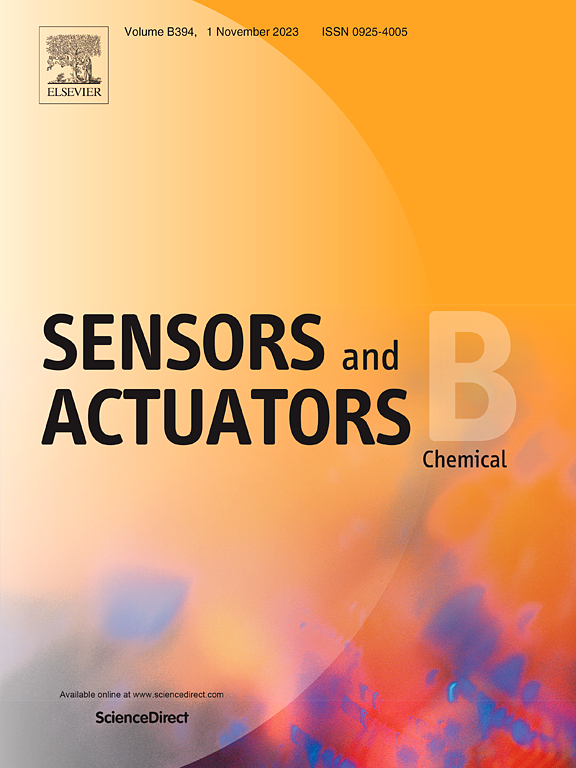An improved electrochemical biosensing device architecture with ultra-thin and surface-modified dielectric stacking structure
IF 8
1区 化学
Q1 CHEMISTRY, ANALYTICAL
引用次数: 0
Abstract
Electrochemical capacitive sensors typically employ a planar electrode (PE) design on a dielectric substrate to evaluate target-induced changes in electrical double-layer (EDL) capacitance. However, as functional substrate areas shrink down to the nanoscale, sensor performance becomes highly sensitive to subtle variations in electrode shape and spacing. These present significant challenges for mass production. To address these issues, we introduce microwell array (MWA) capacitive sensors, which replace the conventional planar layout with a vertically stacked electrode design. This architecture preserves the benefits of nanoscale PE sensors while shifting the fabrication complexity of the sensing area from nanolithography to a more scalable chemical vapor deposition (CVD) process. To evaluate the performance compared to conventional PE-based sensors, we demonstrate biosensing application with the proposed MWA capacitive sensors. In brief, we develop a fabrication process that achieves ultra-thin dielectric layers of 240 nm and 60 nm between MWA electrodes, with fabrication reliability rates of 89.29 % and 50.71 %, respectively. Moreover, simulations reveal that the asymmetric electrode geometry of MWA sensors enhances near-surface current compared to PE sensors. We experimentally show that this effect becomes more pronounced as the dielectric layer thickness decreases. Finally, we also demonstrate that the lateral substrate of MWA sensors supports stable functionalization with an AEAPTES-biotin layer, as confirmed by surface potential measurements. Leveraging these technical advancements, the MWA sensor achieves Avidin and Streptavidin detection limit as 120 fM and 1.76 pM, respectively. These results underscore the potential of the proposed MWA capacitive sensors, demonstrating their superiority over conventional PE sensors for advanced biosensing applications.
一种具有超薄和表面修饰介电层结构的改进电化学生物传感器件结构
电化学电容传感器通常采用介电基板上的平面电极(PE)设计来评估靶诱导的双电层(EDL)电容变化。然而,随着功能衬底面积缩小到纳米级,传感器性能对电极形状和间距的细微变化变得高度敏感。这些都给大规模生产带来了重大挑战。为了解决这些问题,我们引入了微孔阵列(MWA)电容式传感器,它用垂直堆叠的电极设计取代了传统的平面布局。这种结构保留了纳米级PE传感器的优点,同时将传感区域的制造复杂性从纳米光刻转移到更具可扩展性的化学气相沉积(CVD)工艺。为了评估与传统pe传感器相比的性能,我们展示了所提出的MWA电容传感器的生物传感应用。简而言之,我们开发了一种在MWA电极之间实现240 nm和60 nm超薄介电层的制造工艺,制造可靠性分别为89.29%和50.71%。此外,仿真结果表明,与PE传感器相比,MWA传感器的非对称电极几何结构增强了近表面电流。实验表明,随着介质层厚度的减小,这种效应变得更加明显。最后,我们还证明了MWA传感器的横向基底支持aeaptes -生物素层的稳定功能化,正如表面电位测量所证实的那样。利用这些技术进步,MWA传感器分别实现了Avidin和Streptavidin的检测限为120 fM和1.76 pM。这些结果强调了所提出的MWA电容传感器的潜力,证明了它们在先进生物传感应用中优于传统PE传感器的优势。
本文章由计算机程序翻译,如有差异,请以英文原文为准。
求助全文
约1分钟内获得全文
求助全文
来源期刊

Sensors and Actuators B: Chemical
工程技术-电化学
CiteScore
14.60
自引率
11.90%
发文量
1776
审稿时长
3.2 months
期刊介绍:
Sensors & Actuators, B: Chemical is an international journal focused on the research and development of chemical transducers. It covers chemical sensors and biosensors, chemical actuators, and analytical microsystems. The journal is interdisciplinary, aiming to publish original works showcasing substantial advancements beyond the current state of the art in these fields, with practical applicability to solving meaningful analytical problems. Review articles are accepted by invitation from an Editor of the journal.
 求助内容:
求助内容: 应助结果提醒方式:
应助结果提醒方式:


